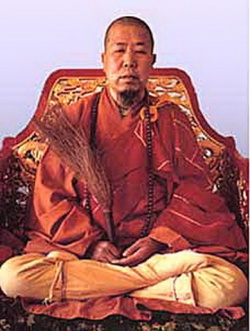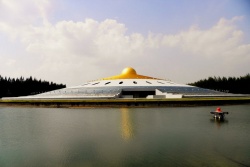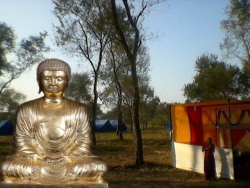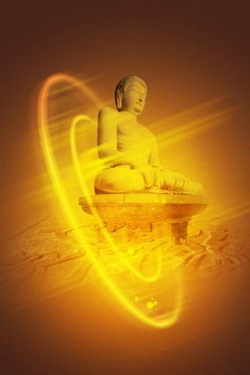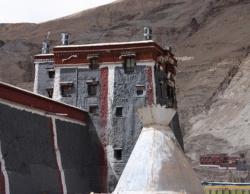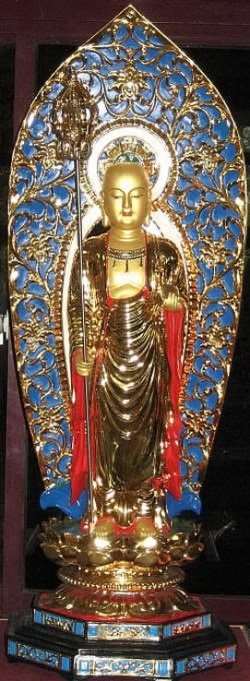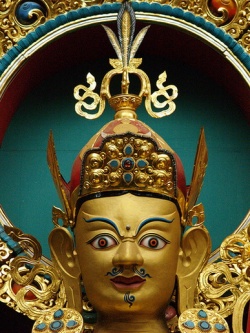Patrons and Priests in Amdo Tibet 1791-1911
This is an ambitious dissertation. The study of nineteenth-century Tibetan and Qing history is a minefield full of explosive nationalist rhetoric, but Max Oidtmann heads straight into the danger, deftly guiding readers through a complicated past far too often silenced in shrill polemics.
In tracing the Qianlong emperor’s attempts to assert Qing sovereignty in Tibet and then the impact of these attempts on the Amdo-Gansu borderlands, Oidtmann argues that a “Qing-centered, pluralistic legal order” emerged in the Tibetan regions of the empire.
Local Qing officials, trying to navigate a path between “transformation and preservation of [the empire’s] non-Han periphery” (p. 567), adjudicated disputes according to a growing corpus of imperially-sanctioned codes and precedents said to embody “Tibetan jurispractice.”
Tibetans, Oidtmann convincingly shows, made ample use of this legal arena, but with results not anticipated by officials.
Rather than binding Amdo to the center, these legal encounters institutionalized large monastic alliances, gave rise to a distinct “Tibetan world,” and reified ethnic identity, the very idea of “Tibetanness.”
Between Patron and Priest draws on the now large body of literature known as “New Qing History,” but also critically engages with the scholarship of colonialism and, especially, legal pluralism, most notably the work of Lauren Benton.
Nineteenth-century Gansu, we learn, had “multiple legal authorities, multiple traditions of jurisprudence, and, most importantly, multiple legal scripts” (p. 11-12).
Tibetan litigants could turn to their own traditions of jurisprudence, or, if a favorable settlement was not found there, “talk Chinese” and appeal to Qing officials, bringing imperial power to bear on local disputes (p. 12).
Oidtmann is able to uncover the details of these legal practices through extensive triangulation in three source languages—Manchu, Tibetan, and Chinese—and mining of both central and local archives and printed histories and hagiographies.
The work is divided into two parts—Part I concentrates on the administrative reforms after the Gurkha invasions of Tibet, particularly the introduction of the Golden Urn, and Part II on local Tibetan-Qing engagements in Amdo.
After a short preface, Chapter 1 begins just after the Qing’s military victory over the Nepalese armies, with the court investigating why Tibetan defenses around Trashi Lhünpo fell so quickly to the invaders.
Through a close reading of Manchu-language memorials, Oidtmann argues that the extension of Qing sovereignty was not part of some grand scheme, but emerged gradually over many months of communications between the Qianlong emperor and his generals in Lhasa.
What the emperor concluded was that Tibetan arts of divination had become corrupted, leading to the recognition of “false lamas”—often with elite and noble ties—and a general “crisis of faith.”
In unprecedented moves, the Qianlong emperor first ordered the execution of a prominent reincarnation involved in the defense of Tashi Lhünpo, thus extending the “king’s law” to both lamas and Tibet.
He then sought a way to rectify the selection of kūtuktu, a title reserved for recognized lamas who exercise spiritual control over the reincarnation process.
Here, the Qianlong emperor resurrected a Ming-era lottery system for civil appointments, the Golden Urn, as the Gurkha invasion was understood, after all, a result of the “moral failings” of the lay and ecclesiastical elite and thus a crisis of “personnel” (p. 90). Oidtmann’s contributions here are both novel and important.
The Golden Urn and the emperor’s Discourse on Lamas (translated as an appendix), and the Qianlong emperor’s professed “faith” in Buddhism more generally, have long been understood in rather reductionist terms—mere political expedients.
Between Patron and Priest argues for a more complex interpretation.
As Oidtmann notes, the main concern was the “believability of reincarnations” and “the articulation of the emperor’s sovereignty over Tibet was intimately linked to his concern with controlling the arts of divination” (p. 110).
Chapter 2, “Shamanic Imperialism,” details the Qing court’s persecution of Tibetan divination and the first attempts to use the Golden Urn.
In 1793, the recognition of the Erdeni Bandida as the scion of a powerful Mongol jasak—hereditary aristocracy enfeoffed by Qing rulers—provided the Qianlong emperor a casus belli for his war against the oracles and a first test-case for the use of the Golden Urn.
The ensuing investigations uncovered what the Qing took to be corruption in the divination process, “bribes” to ensure the selection of a favored candidate, and a new, subsequent selection was picked from the Golden Urn in Beijing’s Yonghegong.
Oracles, it was said, were like the “false shamans” of the interior, tricking the masses and stealing their wealth.
As the Qianlong emperor opined, the reselection of the Erdeni Bandida was a “victory of law-making,” and it was hoped that Tibetans would forego their “corrupted” divination technologies for the just laws of the empire (p. 196).
It is not clear how well any of this translated into Tibetan, however, as the trope of “false shamans” would simply have not been intelligible from a Tibetan perspective.
In fact, what the Qianlong emperor took as “law,” Tibetan writers continued to see as “omen” (p. 191).
Chapter 3 continues these themes, with a particular focus on the 1797 recognition of the third Jamyang Zhepa, the main reincarnate lineage from Labrang Monastery in Amdo.
Here, Oidtmann relies on the Tibetan-language biographies of the second and third Jamyang Zhepa and details the journey of Labrang’s delegation, headed by the second Belmang Pandita Kӧnchok Gyeltsen, to Lhasa.
The recognition process, he finds, was significantly altered by the Manchu ambans and held, not at the Jokhang, but at the Potala Palace in front of an image of the Qianlong emperor.
There had been significant meddling in, even manipulation of, the ritual.
Indeed, Oidtmann, through comparisons of the Tibetan- and Manchu-language record, uncovers that the favored candidate of Labrang—the son of a local Amdo leader—had been scrapped for another child.
The Labrang community had significant misgivings about the selection and the Golden Urn ritual in general, but, over the course of a century, hagiographic writings gradually accepted the framework.
“Tibetan Buddhists,” Oidtmann writes, “harmonized two seemingly incompatible systems for locating reincarnations and naturalized the result of a highly contentious and unexpected identification” (p. 206).
In Chapter 4, the first section of Part II, we follow Belmang Pandita Kӧnchok Gyeltsen back to Labrang. Belmang might have accepted the controversial selection of the third Jamyang Zhepa, but he did not share all of the Qing state’s new discursive framework.
His History of India, Tibet, and Mongolia, a political treatise to educate leaders, made a strident case for “Buddhist governance and law,” the targets of Qing “rectification” campaigns (p. 266).
The Qianlong emperor, as imagined here, is not Manjusri and there is little mention of a “Great Qing” empire—the Manchu realm identified simply as “China.” The Qing state, Belmang argued, was incapable of upholding Buddhist laws and maintaining order.
In an unstable time, faced with the fading influence of Labrang’s Qinghai Mongol benefactors and Qing state interventions, the Labrang-based scholar forcefully argued not only for Buddhist jurisprudence, but for the place of Tibetan hierarchs in the mediation of disputes and the practice of law.
“To Be ‘One’s Own Master,” Chapter 5, describes the polity of the Fifth Lamo Cagan Nomunhan Kūtuktu, an important Gelukpa reincarnation from Amdo and also the head of a nomadic banner.
Holding both spiritual and secular authority, he was described as a “jasak lama.”
Belmang Pandita identified the Cagan Nomunhan as an example of Buddhist jurisprudence, but for Qing officials involved in the suppression of borderland violence in the 1820s the Cagan Nomunhan’s polity would “become a symbol of how untenable the prevailing system of governance in the region had become and the continued dangers of rule by reincarnate lamas” (p. 342).
Based primarily on Nayanceng’s Pingfan zouyi (“Memorials Concerning Pacifying Tibetans”), Oidtmann shows that the accommodations reached during the late Qianlong reign, however tenuous, had frayed by the Daoguang period (1821-1850).
The contrasting imperial visions of “statecraft” officials and Tibetan Buddhists “left increasingly little room for re-interpretation and acceptance by the other side” (p. 402).
The last two chapters of Between Patron and Priest
center on law and the colonial order in Xunhua subprefecture, which came to oversee the Tibetan communities of southern Gansu, including Labrang.
Quite paradoxically, though the visions of Tibetan Buddhists and officials might have increasingly diverged, Tibetan litigants made ample use of Qing legal channels.
After the suppression of the Lobzang Danjin rebellion (1723), Qing officials significantly rearranged the legal order in the Amdo-Gansu borderlands and promulgated a series of laws known as the “Tibetan Codes.”
These laws were meant to be “provisional,” easing the transition of the now tax-paying Tibetan subjects of Gansu into the empire, but 180 years after being first disseminated they remained in effect.
Within the Qing state, there was now a legitimate space for “Tibetan jurisprudence,” a consequence quite “unforeseen” by Yongzheng-era officials (p. 419).
In this “Qing-centered pluralistic legal regime,” Oidtmann identifies five elements that would come to define adjudication:
1) a “shared conviction” by both Tibetans and Qing officials that disputes be resolved according to “Tibetan laws and statutes;”
2) an expectation that prior jurisprudence guide decisions;
3) the significance of written documents;
4) the chance for “forum shopping,” appealing to differing legal authorities; and
5) the use of “mutually intelligible tropes” such as the “violent Tibetan” (p. 427-429).
The final chapter looks at the actual adjudication of several disputes drawn from the hitherto unused archives of Xunhua subprefecture in the decades after the Muslim rebellions.
Tibetan litigants made extensive use of the Qing legal system and filed mountains of petitions.
The majority of these documents were submitted by secular and religious leaders charging a range of violent offenses—including the illegal subjugation of neighboring communities—in the increasingly acrimonious disputes between Labrang, Rongwo, and Tsӧ Monasteries.
The Tibetan reliance on the Xunhua yamen led an often reluctant Qing state, and the Muslim elites deputized to handle frontier matters, to increase their involvement in local Tibetan affairs.
Colonial officials stumbled into monastic feuds they did not completely understand and, in their settlements, unwittingly served as “midwife” to the emergence of huge monastic confederations,
“warring states” from whose litigiousness the Qing state “could no longer extract itself” (p. 10). Despite the fractured nature of Amdo, all the various disputants “met before the magistrate as ‘Tibetans’” (p. 538).
The very idea of “Tibetan,” in other words, was reified before colonial officials. In this way, Oidtmann concludes, “the ‘Tibetan world’ was at least partially a product of Qing colonial administrators, despite their best efforts to obstruct its emergence” (p. 539).
If this all seems rather complex, it’s because it is. Between Patron and Priest is both an encyclopedic treasure trove of information and an important intervention into scholarly debates in a range of fields—Tibetan history, Qing history, colonial studies, and legal pluralism.
Through his use of a range of sources in several different languages, Oidtmann brings a completely new level of depth and detail to discussions of the Tibetan-Qing encounter. And, as his epilogue suggests, the tensions uncovered in his dissertation still echo on today.
Wesley Chaney
History Department
wbchaney@stanford.edu
Primary Sources Junjichu Manwen lufu zouzhe (Manchu Palace Memorial Record Books of the Grand Council), First Historical Archives, Beijing
Dbal mang dkon mchog rgyal mtshan, Rgya bod hor sog gyi lo rgyus nyung brjod pa byis pa ‘jug pa’i ‘bab stegs (A History of India, Tibet, and Mongolia)
Archive of Xunhua Subprefecture (Qinghai sheng dang’anguan Xunhua ting dang’an), Qinghai Provincial Archives
Na-yan-cheng (Nayanceng), Pingfan zouyi (Memorials Concerning Pacifying Tibetans)
Brag dgon dkon mchog bstan pa rab rgyas, Mdo smad chos ‘byung (History of the Faith in Amdo) / Deb ther rgyar mtsho (The Oceanic Book)
Dissertation Information Harvard University. 2013. 629 pp. Primary Advisor: Mark C. Elliott.
Image: Finding of a Dalai Lama, Harvard Art Museums, Arthur M. Sackler Museum, Bequest of the Hofer Collection of the Arts of Asia, 1985.863.5. The album is undated. It likely depicts the identification of the ninth Dalai Lama in 1808.
